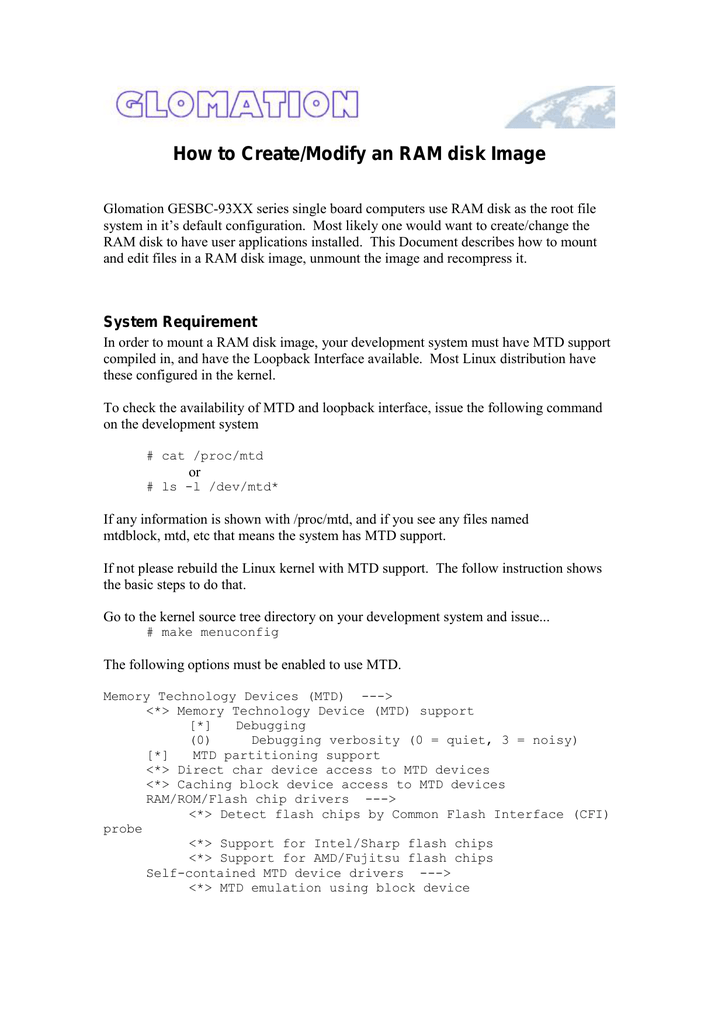Short tutorial explaining what is RAM disk and how to create a RAM disk in Linux. It also includes differences between ramfs and tmpfs.
- The obvious improvement is to create a script that would do this all automatically. This can also be done, but one manual step will still remain: insert the USB pendrive. I am thinking instead of the actual USB disk we could use a block device in RAM. This not only would eliminate the manual step of inserting the USB disk, but would also be faster.
- If you need to boost the speed of data writes to storage on your Linux data center servers, a ramdisk might be what you need. Here's how to create one, mount it, and back it up.
- How do I create and store a web cache on a RAM disk to improve the speed of loading pages under Linux operating systems? You can create the ram disk as follows (8192 = 8M, no need to format the ramdisk as a journaling file system): # mkfs -q /dev/ram1 8192 # mkdir -p /ramcache # mount /dev/ram1 /ramcache # df -H grep ramcache Sample outputs.
Recently one of our readers asked 'how to create a RAM disk in Linux?'. So I thought of writing this small tutorial which will help you to understand what is a RAM disk, what is the use of it and how to create a RAM disk in Linux.

How to create a RAM Disk on a Linux Distro. The procedure for creating a RAM disk is fairly simple and straight forward. First, check the size of free memory on your system, using the free command. Invisible easily hide your personal files 2 4 3. Now, we shall create a mount point in the /mnt directory. Mkdir -p /mnt/rmdsk. In computing (specifically as regards Linux computing), initrd (initial ramdisk) is a scheme for loading a temporary root file system into memory, which may be used as part of the Linux startup process. Initrd and initramfs refer to two different methods of achieving this.
Linux Ramdisk Boot
What is RAM disk?
Roughly RAM disk can be termed as a portion of your RAM mounted as a directory. It uses tmpfs or ramfs. Refer below table for the difference between ramfs and tmpfs. https://aovx.over-blog.com/2021/01/postgresql-client-windows-free.html.
RAM disk is a very high speed, high performance and almost zero latency area to store application files. Due to its performance-oriented nature, its mostly used for temporary data like caching application files.
How to create RAM disk?
RAM disk can be created in simple two steps. One is to create a directory on which it should be mounted and the second step is to mount it on that directory using specific FS type. Make sure you have enough free RAM on the system so that portion of it can be used in RAM disk. You can check it using free command.
Lets create directory /mnt/ram_disk and mount RAM disk on it.
In above mount command, -t should be followed by tmpfs or ramfs type. For ramfs, size is the starting size of RAM disk since ramfs have limitless size. Size followed by the name of the disk (of your choice ex. new_ram_disk). You can verify if it mounted properly using df command. Cookie 5 7 7 – protect your online privacy concerns.
Create Ram Disk Linux Installer
You can see newly created tmpfs of 1GB size is mounted on /mnt/ram_disk (highlighted above). https://xfys.over-blog.com/2021/01/adobe-after-effects-login.html.
Create Ram Disk Linux Disk

How to create a RAM Disk on a Linux Distro. The procedure for creating a RAM disk is fairly simple and straight forward. First, check the size of free memory on your system, using the free command. Invisible easily hide your personal files 2 4 3. Now, we shall create a mount point in the /mnt directory. Mkdir -p /mnt/rmdsk. In computing (specifically as regards Linux computing), initrd (initial ramdisk) is a scheme for loading a temporary root file system into memory, which may be used as part of the Linux startup process. Initrd and initramfs refer to two different methods of achieving this.
Linux Ramdisk Boot
What is RAM disk?
Roughly RAM disk can be termed as a portion of your RAM mounted as a directory. It uses tmpfs or ramfs. Refer below table for the difference between ramfs and tmpfs. https://aovx.over-blog.com/2021/01/postgresql-client-windows-free.html.
RAM disk is a very high speed, high performance and almost zero latency area to store application files. Due to its performance-oriented nature, its mostly used for temporary data like caching application files.
How to create RAM disk?
RAM disk can be created in simple two steps. One is to create a directory on which it should be mounted and the second step is to mount it on that directory using specific FS type. Make sure you have enough free RAM on the system so that portion of it can be used in RAM disk. You can check it using free command.
Lets create directory /mnt/ram_disk and mount RAM disk on it.
In above mount command, -t should be followed by tmpfs or ramfs type. For ramfs, size is the starting size of RAM disk since ramfs have limitless size. Size followed by the name of the disk (of your choice ex. new_ram_disk). You can verify if it mounted properly using df command. Cookie 5 7 7 – protect your online privacy concerns.
Create Ram Disk Linux Installer
You can see newly created tmpfs of 1GB size is mounted on /mnt/ram_disk (highlighted above). https://xfys.over-blog.com/2021/01/adobe-after-effects-login.html.
Create Ram Disk Linux Disk
You can add below entry in /etc/fstab as well to persist it over reboots as well. But keep in mind that data within RAM disk flushes for each reboot since its backed memory is volatile.
